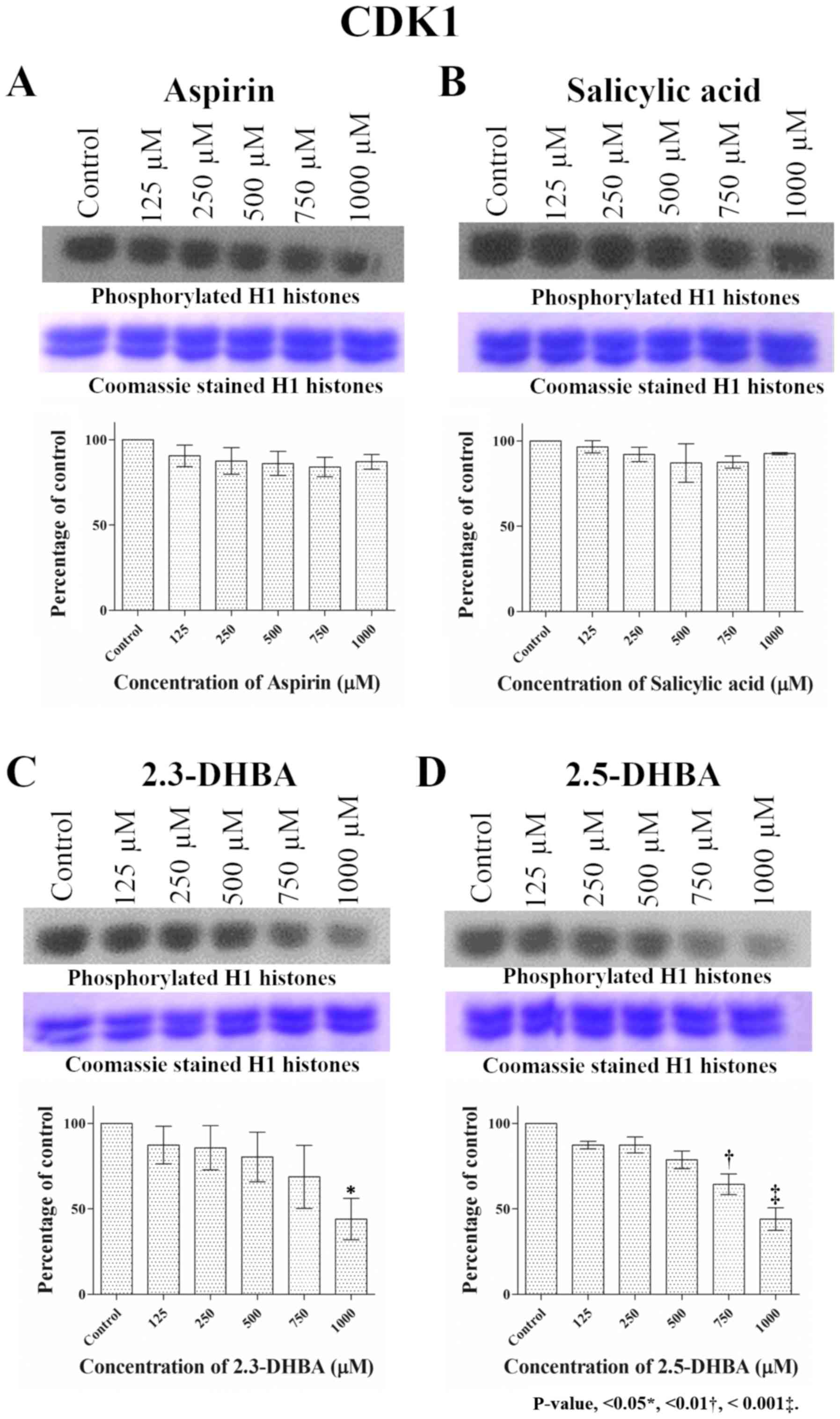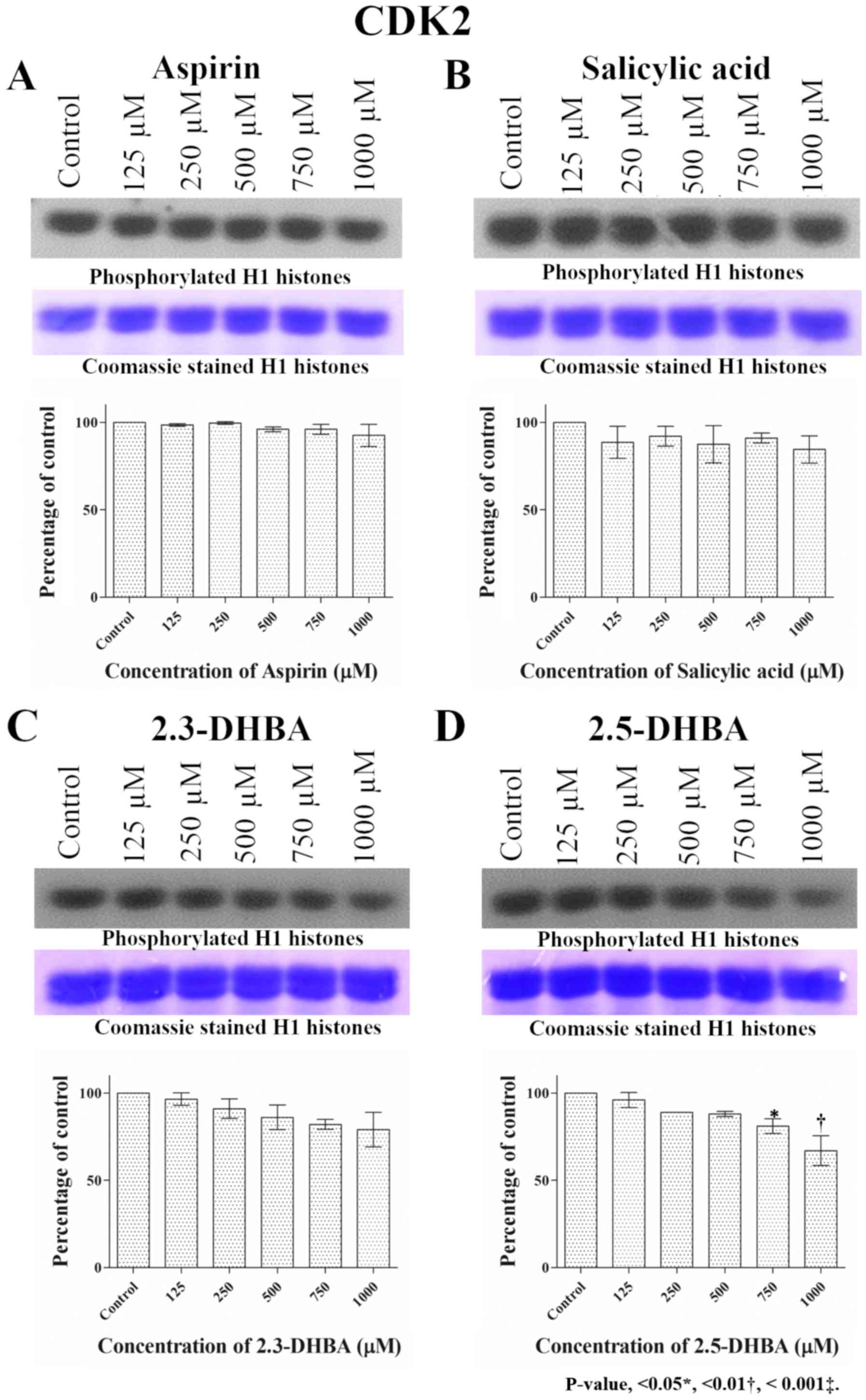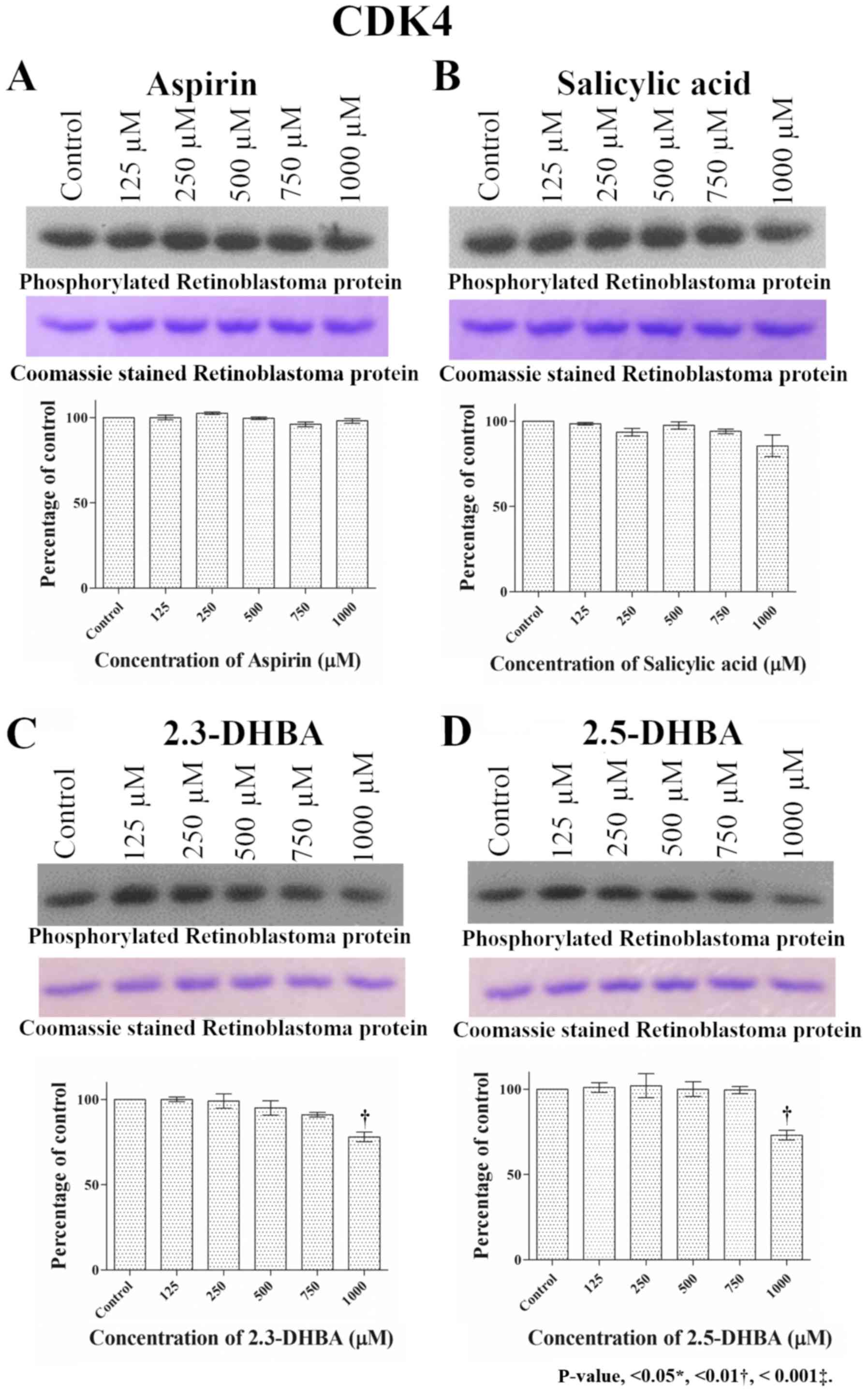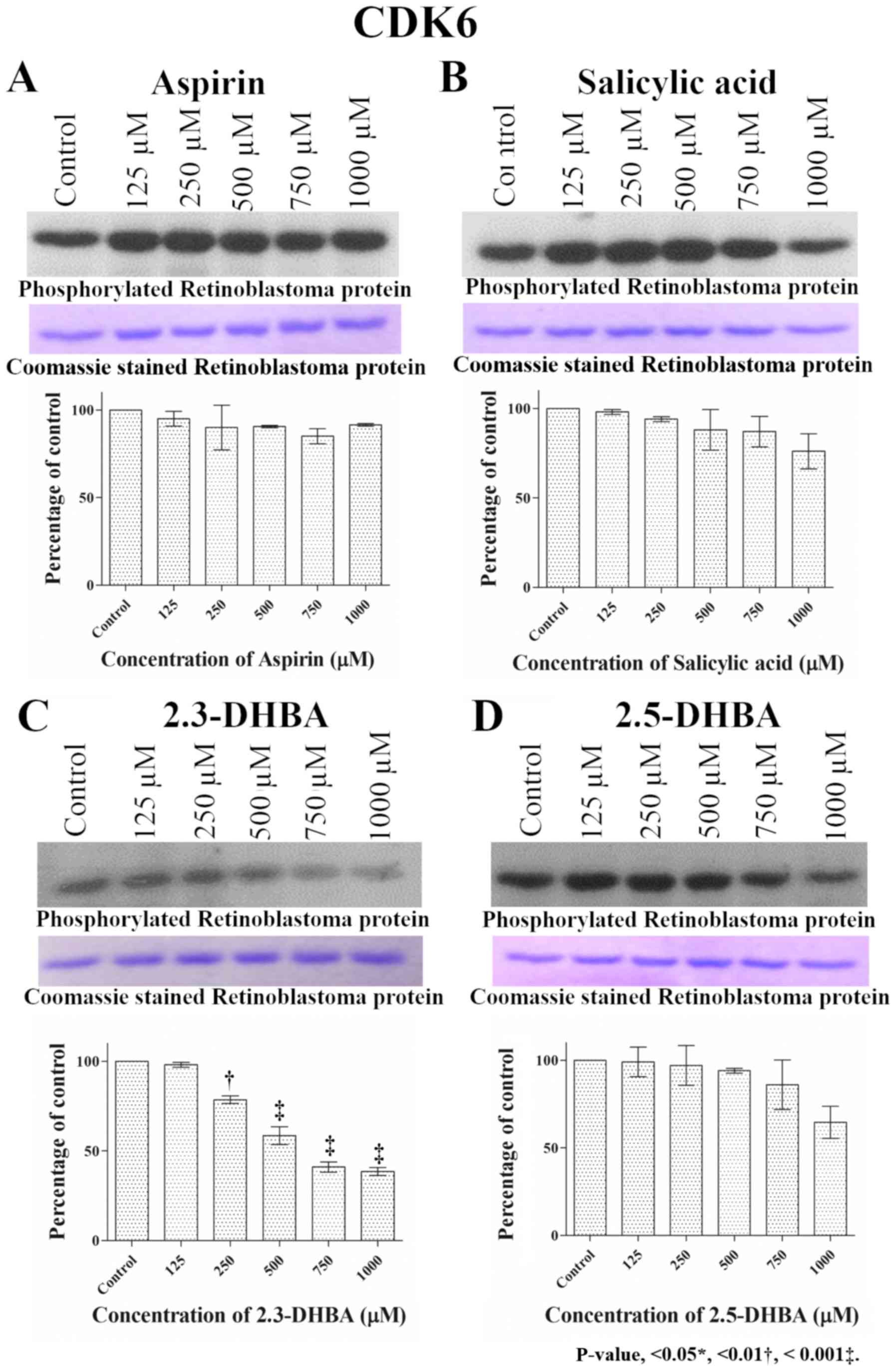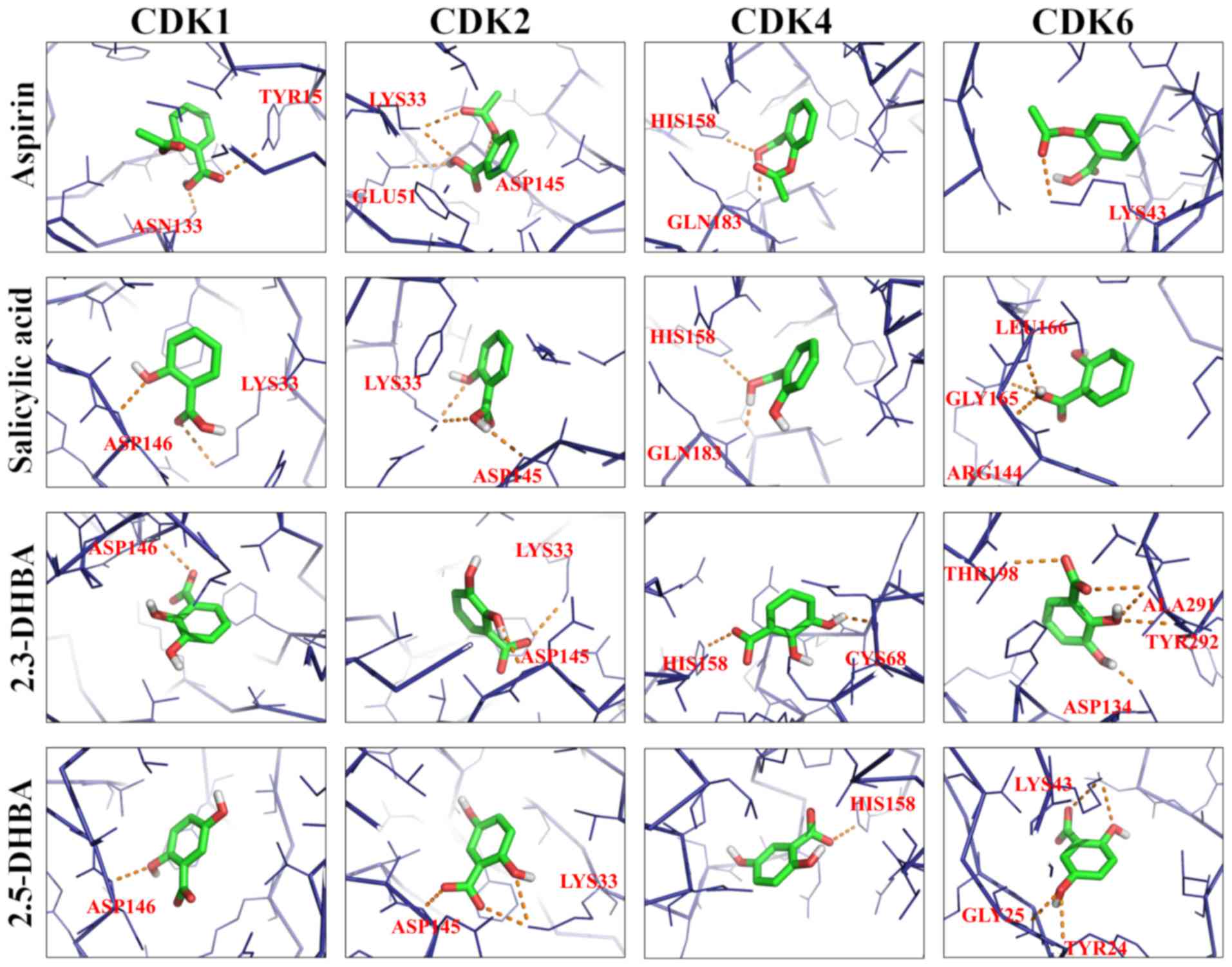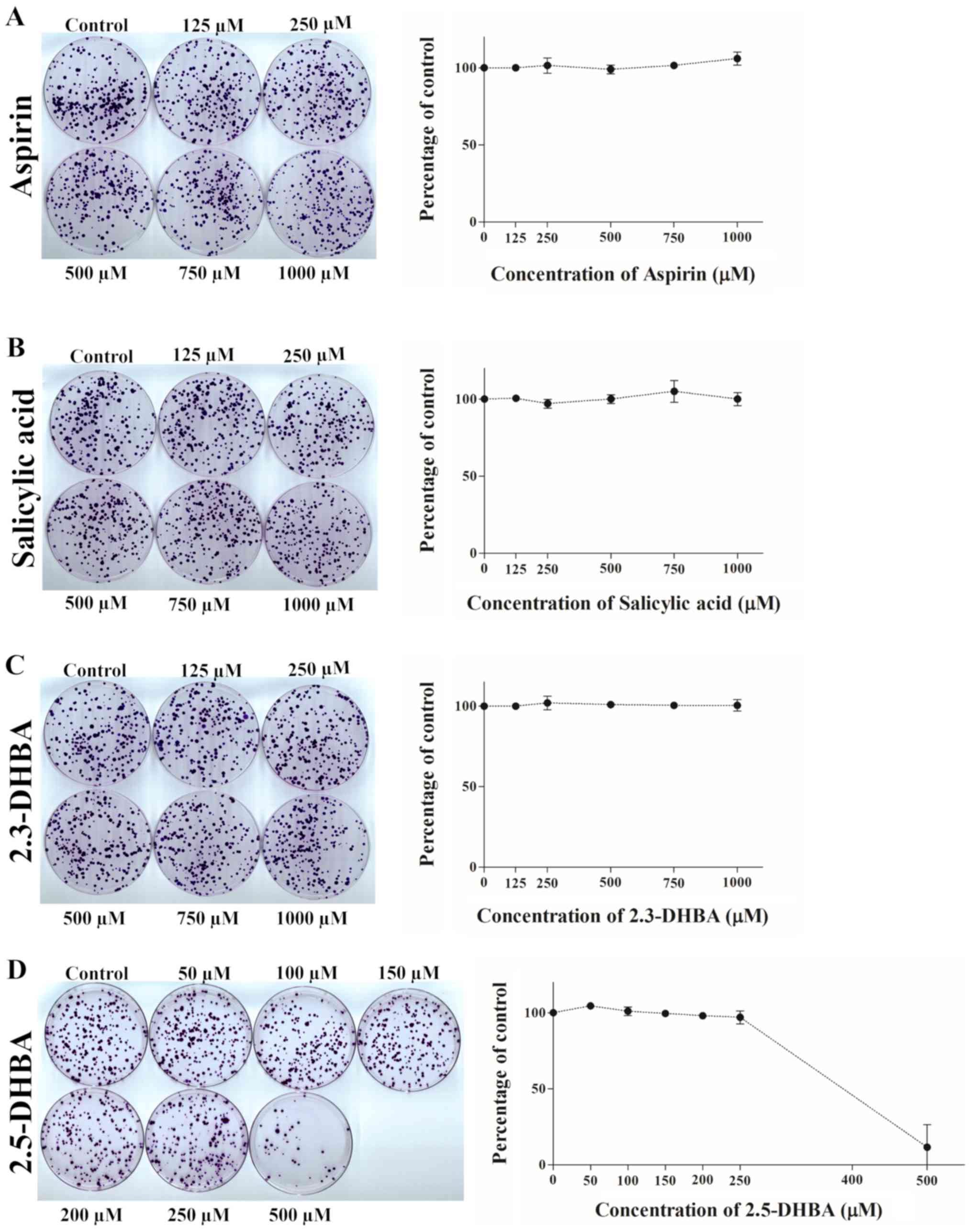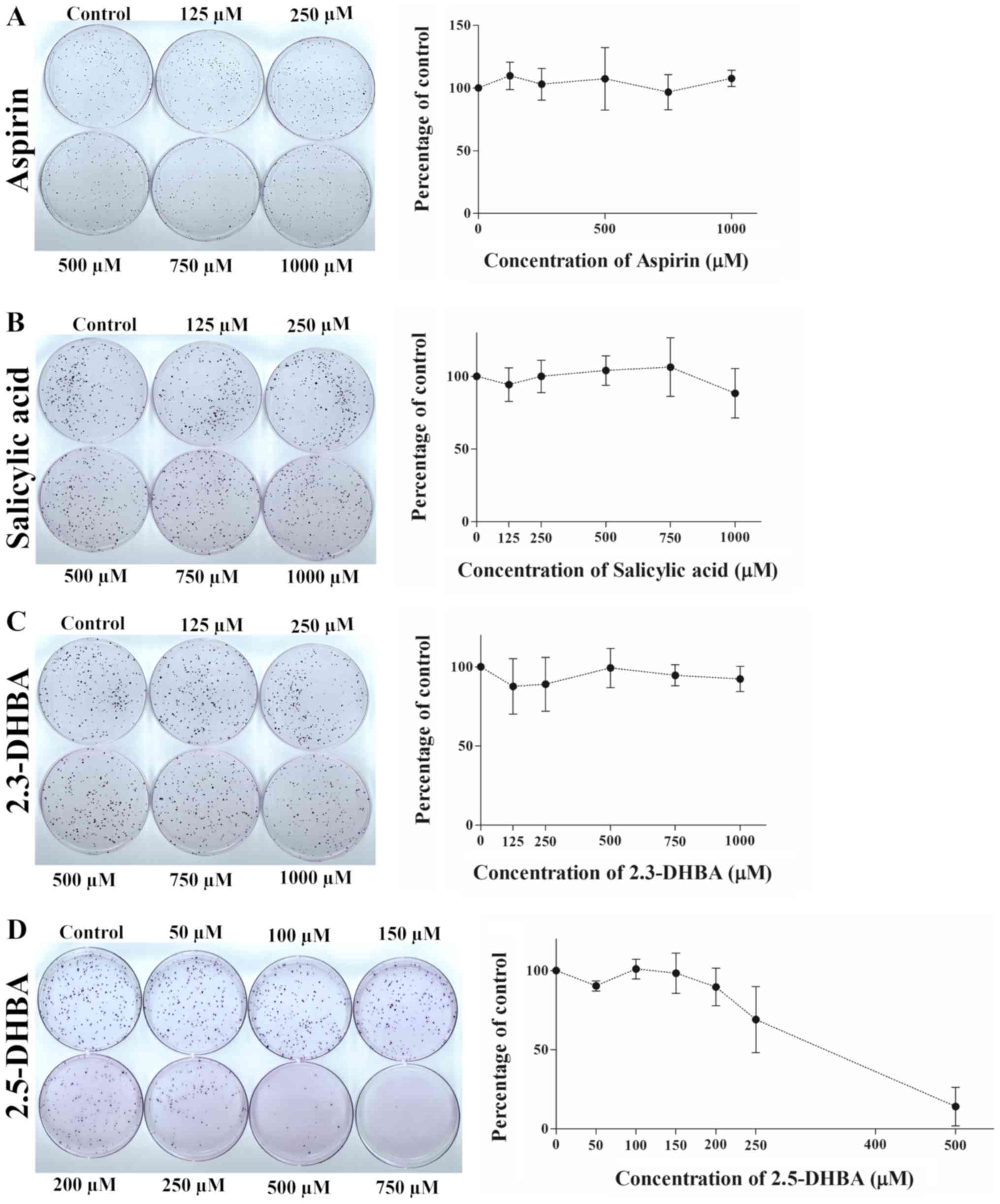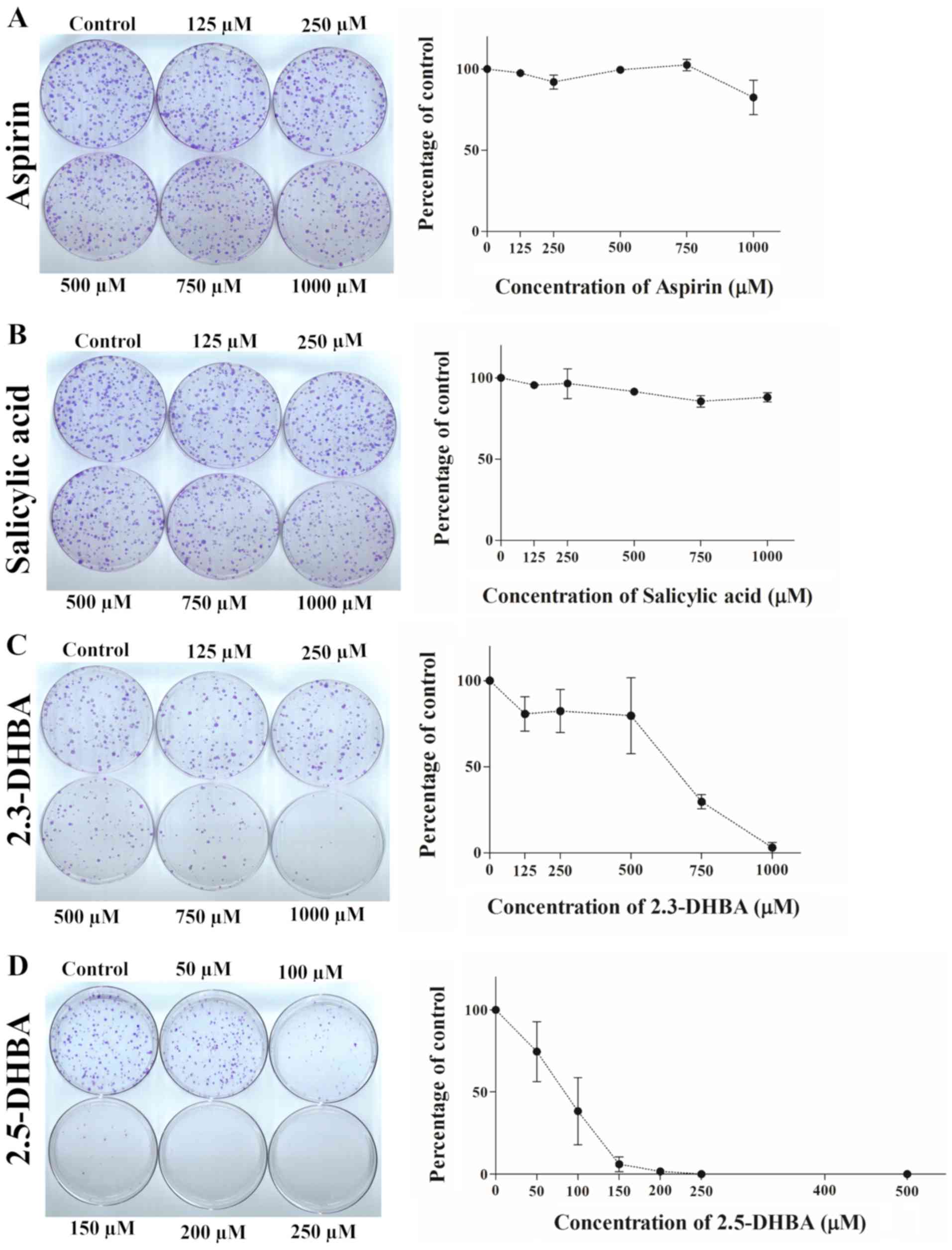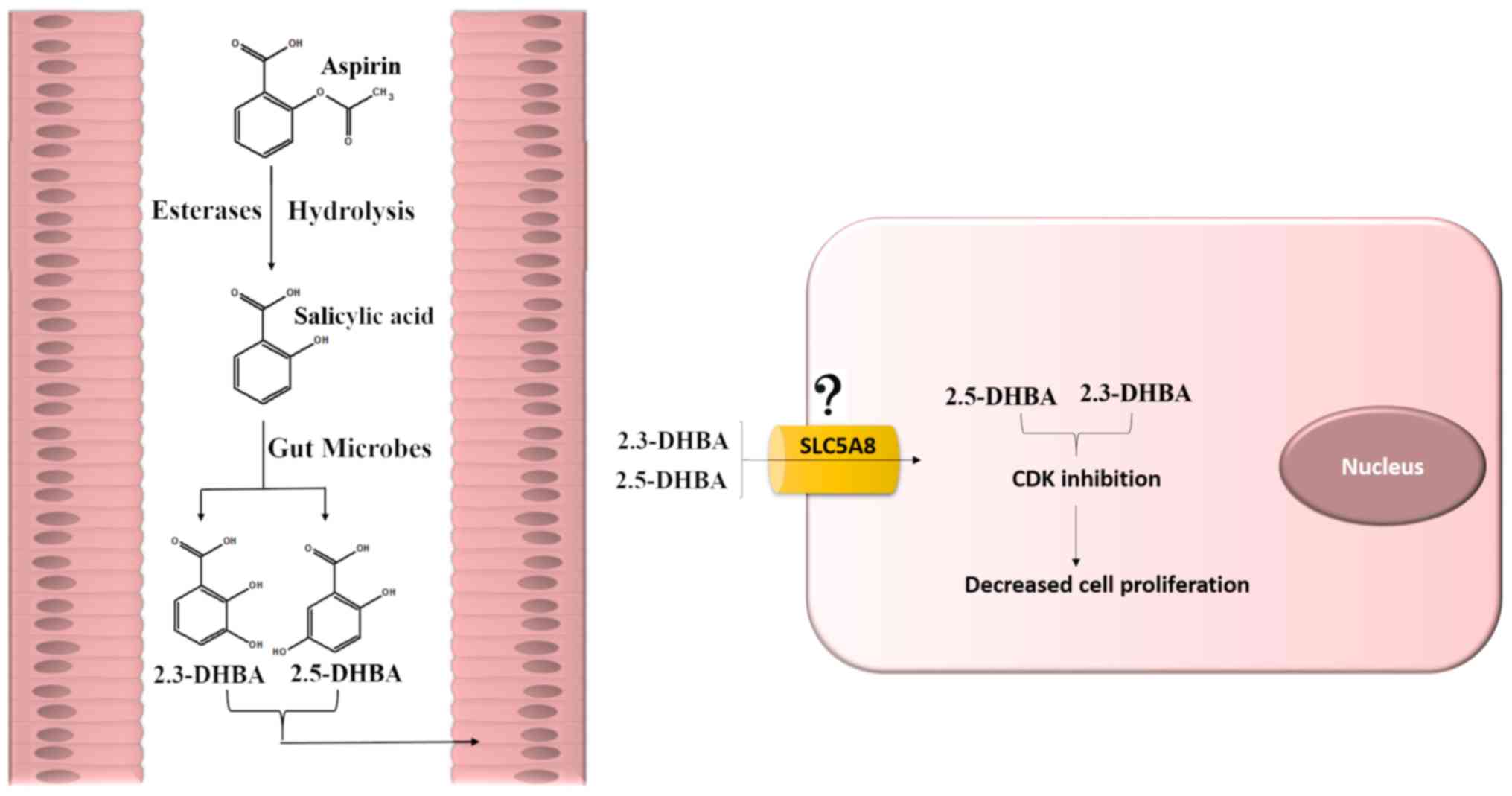|
1
|
Vane JR and Botting RM: The mechanism of
action of aspirin. Thromb Res. 110:255–258. 2003. View Article : Google Scholar : PubMed/NCBI
|
|
2
|
Vane JR: Inhibition of prostaglandin
synthesis as a mechanism of action for aspirin-like drugs. Nat New
Biol. 231:232–235. 1971. View Article : Google Scholar : PubMed/NCBI
|
|
3
|
Roth GJ and Majerus PW: The mechanism of
the effect of aspirin on human platelets. I. Acetylation of a
particulate fraction protein. J Clin Invest. 56:624–632. 1975.
View Article : Google Scholar : PubMed/NCBI
|
|
4
|
Hennekens CH: Update on aspirin in the
treatment and prevention of cardiovascular disease. Am J Manag
Care. 8 (22 Suppl):S691–S700. 2002.PubMed/NCBI
|
|
5
|
Rothwell PM, Price JF, Fowkes FG,
Zanchetti A, Roncaglioni MC, Tognoni G, Lee R, Belch JF, Wilson M,
Mehta Z and Meade TW: Short-term effects of daily aspirin on cancer
incidence, mortality, and non-vascular death: Analysis of the time
course of risks and benefits in 51 randomised controlled trials.
Lancet. 379:1602–1612. 2012. View Article : Google Scholar : PubMed/NCBI
|
|
6
|
Rothwell PM, Wilson M, Elwin CE, Norrving
B, Algra A, Warlow CP and Meade TW: Long-term effect of aspirin on
colorectal cancer incidence and mortality: 20-year follow-up of
five randomised trials. Lancet. 376:1741–1750. 2010. View Article : Google Scholar : PubMed/NCBI
|
|
7
|
Rothwell PM, Wilson M, Price JF, Belch JF,
Meade TW and Mehta Z: Effect of daily aspirin on risk of cancer
metastasis: A study of incident cancers during randomised
controlled trials. Lancet. 379:1591–1601. 2012. View Article : Google Scholar : PubMed/NCBI
|
|
8
|
Bibbins-Domingo K; U.S. Preventive
Services Task Force, : Aspirin use for the primary prevention of
cardiovascular disease and colorectal cancer: U.S. Preventive
services task force recommendation statement. Ann Intern Med.
164:836–845. 2016. View
Article : Google Scholar : PubMed/NCBI
|
|
9
|
Thun MJ, Jacobs EJ and Patrono C: The role
of aspirin in cancer prevention. Nat Rev Clin Oncol. 9:259–267.
2012. View Article : Google Scholar : PubMed/NCBI
|
|
10
|
Patrono C: The Multifaceted clinical
readouts of platelet inhibition by low-dose aspirin. J Am Coll
Cardiol. 66:74–85. 2015. View Article : Google Scholar : PubMed/NCBI
|
|
11
|
Patrignani P and Patrono C: Aspirin,
platelet inhibition and cancer prevention. Platelets. 29:779–785.
2018. View Article : Google Scholar : PubMed/NCBI
|
|
12
|
Patrignani P and Patrono C: Aspirin and
cancer. J Am Coll Cardiol. 68:967–976. 2016. View Article : Google Scholar : PubMed/NCBI
|
|
13
|
Dovizio M, Alberti S, Guillem-Llobat P and
Patrignani P: Role of platelets in inflammation and cancer: Novel
therapeutic strategies. Basic Clin Pharmacol Toxicol. 114:118–127.
2014. View Article : Google Scholar : PubMed/NCBI
|
|
14
|
Chan AT, Arber N, Burn J, Chia WK, Elwood
P, Hull MA, Logan RF, Rothwell PM, Schrör K and Baron JA: Aspirin
in the chemoprevention of colorectal neoplasia: An overview. Cancer
Prev Res (Phila). 5:164–178. 2012. View Article : Google Scholar : PubMed/NCBI
|
|
15
|
Kopp E and Ghosh S: Inhibition of NF-kappa
B by sodium salicylate and aspirin. Science. 265:956–959. 1994.
View Article : Google Scholar : PubMed/NCBI
|
|
16
|
Dovizio M, Bruno A, Tacconelli S and
Patrignani P: Mode of action of aspirin as a chemopreventive agent.
Recent Results Cancer Res. 191:39–65. 2013. View Article : Google Scholar : PubMed/NCBI
|
|
17
|
Din FV, Valanciute A, Houde VP, Zibrova D,
Green KA, Sakamoto K, Alessi DR and Dunlop MG: Aspirin inhibits
mTOR signaling, activates AMP-activated protein kinase, and induces
autophagy in colorectal cancer cells. Gastroenterology.
142:1504–1515.e3. 2012. View Article : Google Scholar : PubMed/NCBI
|
|
18
|
Hawley SA, Fullerton MD, Ross FA,
Schertzer JD, Chevtzoff C, Walker KJ, Peggie MW, Zibrova D, Green
KA, Mustard KJ, et al: The ancient drug salicylate directly
activates AMP-activated protein kinase. Science. 336:918–922. 2012.
View Article : Google Scholar : PubMed/NCBI
|
|
19
|
Gala MK and Chan AT: Molecular pathways:
Aspirin and Wnt signaling-a molecularly targeted approach to cancer
prevention and treatment. Clin Cancer Res. 21:1543–1548. 2015.
View Article : Google Scholar : PubMed/NCBI
|
|
20
|
Ai G, Dachineni R, Muley P, Tummala H and
Bhat GJ: Aspirin and salicylic acid decrease c-Myc expression in
cancer cells: A potential role in chemoprevention. Tumour Biol.
37:1727–1738. 2016. View Article : Google Scholar : PubMed/NCBI
|
|
21
|
Goel A, Chang DK, Ricciardiello L, Gasche
C and Boland CR: A novel mechanism for aspirin-mediated growth
inhibition of human colon cancer cells. Clin Cancer Res. 9:383–390.
2003.PubMed/NCBI
|
|
22
|
Pietrocola F, Castoldi F, Markaki M,
Lachkar S, Chen G, Enot DP, Durand S, Bossut N, Tong M, Malik SA,
et al: Aspirin recapitulates features of caloric restriction. Cell
Rep. 22:2395–2407. 2018. View Article : Google Scholar : PubMed/NCBI
|
|
23
|
Ai G, Dachineni R, Kumar DR, Marimuthu S,
Alfonso LF and Bhat GJ: Aspirin acetylates wild type and mutant p53
in colon cancer cells: Identification of aspirin acetylated sites
on recombinant p53. Tumour Biol. 37:6007–6016. 2016. View Article : Google Scholar : PubMed/NCBI
|
|
24
|
Ai G, Dachineni R, Kumar DR, Alfonso LF,
Marimuthu S and Bhat GJ: Aspirin inhibits glucose-6-phosphate
dehydrogenase activity in HCT 116 cells through acetylation:
Identification of aspirin-acetylated sites. Mol Med Rep.
14:1726–1732. 2016. View Article : Google Scholar : PubMed/NCBI
|
|
25
|
Rigas B and Tsioulias GJ: The evolving
role of nonsteroidal anti-inflammatory drugs in colon cancer
prevention: A cause for optimism. J Pharmacol Exp Ther. 353:2–8.
2015. View Article : Google Scholar : PubMed/NCBI
|
|
26
|
Bosetti C, Rosato V, Gallus S, Cuzick J
and La Vecchia C: Aspirin and cancer risk: A quantitative review to
2011. Ann Oncol. 23:1403–1415. 2012. View Article : Google Scholar : PubMed/NCBI
|
|
27
|
Harris RE, Beebe-Donk J, Doss H and Burr
Doss D: Aspirin, ibuprofen, and other non-steroidal
anti-inflammatory drugs in cancer prevention: A critical review of
non-selective COX-2 blockade (review). Oncol Rep. 13:559–583.
2005.PubMed/NCBI
|
|
28
|
Cao Y, Nishihara R, Wu K, Wang M, Ogino S,
Willett WC, Spiegelman D, Fuchs CS, Giovannucci EL and Chan AT:
Population-wide impact of long-term use of aspirin and the risk for
cancer. JAMA Oncol. 2:762–769. 2016. View Article : Google Scholar : PubMed/NCBI
|
|
29
|
Bojić M, Sedgeman CA, Nagy LD and
Guengerich FP: Aromatic hydroxylation of salicylic acid and aspirin
by human cytochromes P450. Eur J Pharm Sci. 73:49–56. 2015.
View Article : Google Scholar : PubMed/NCBI
|
|
30
|
Kim IS, Yoo DH, Jung IH, Lim S, Jeong JJ,
Kim KA, Bae ON, Yoo HH and Kim DH: Reduced metabolic activity of
gut microbiota by antibiotics can potentiate the antithrombotic
effect of aspirin. Biochem Pharmacol. 122:72–79. 2016. View Article : Google Scholar : PubMed/NCBI
|
|
31
|
Dachineni R, Kumar DR, Callegari E,
Dachineni R, Kumar DR, Callegari E, Kesharwani SS, Sankaranarayanan
R, Seefeldt T, Tummala H and Bhat GJ: Salicylic acid metabolites
and derivatives inhibit CDK activity: Novel insights into aspirin's
chemopreventive effects against colorectal cancer. Int J Oncol.
51:1661–1673. 2017. View Article : Google Scholar : PubMed/NCBI
|
|
32
|
DK2 kinase assay, . https://www.signalchem.com/shared_product_sheets/N211-4.pdf
|
|
33
|
CDK1 Kinase assay, . https://www.signalchem.com/shared_product_sheets/F625-2.pdf
|
|
34
|
CDK4 Kinase assay, . https://www.signalchem.com/shared_product_sheets/R219-1.pdf
|
|
35
|
CDK6 Kinase assay, . https://www.signalchem.com/shared_product_sheets/D062-1.pdf
|
|
36
|
Sankaranarayanan R, Valiveti CK, Kumar DR,
Van Slambrouck S, Kesharwani SS, Seefeldt T, Scaria J, Tummala H
and Bhat GJ: The flavonoid metabolite 2,4,6-trihydroxybenzoic acid
is a CDK inhibitor and an anti-proliferative agent: A potential
role in cancer prevention. Cancers (Basel). 11(pii): E4272019.
View Article : Google Scholar : PubMed/NCBI
|
|
37
|
Dachineni R, Ai G, Kumar DR, Sadhu SS,
Tummala H and Bhat GJ: Cyclin A2 and CDK2 as novel targets of
aspirin and salicylic acid: A potential role in cancer prevention.
Mol Cancer Res. 14:241–252. 2016. View Article : Google Scholar : PubMed/NCBI
|
|
38
|
Van Der Spoel D, Lindahl E, Hess B,
Groenhof G, Mark AE and Berendsen HJ: GROMACS: Fast, flexible, and
free. J Comput Chem. 26:1701–1718. 2005. View Article : Google Scholar : PubMed/NCBI
|
|
39
|
Wu SY, McNae I, Kontopidis G, McClue SJ,
McInnes C, Stewart KJ, Wang S, Zheleva DI, Marriage H, Lane DP, et
al: Discovery of a novel family of CDK inhibitors with the program
LIDAEUS: Structural basis for ligand-induced disordering of the
activation loop. Structure. 11:399–410. 2003. View Article : Google Scholar : PubMed/NCBI
|
|
40
|
Din FV, Dunlop MG and Stark LA: Evidence
for colorectal cancer cell specificity of aspirin effects on NF
kappa B signalling and apoptosis. Br J Cancer. 91:381–388. 2004.
View Article : Google Scholar : PubMed/NCBI
|
|
41
|
Qiao L, Hanif R, Sphicas E, Shiff SJ and
Rigas B: Effect of aspirin on induction of apoptosis in HT-29 human
colon adenocarcinoma cells. Biochem Pharmacol. 55:53–64. 1998.
View Article : Google Scholar : PubMed/NCBI
|
|
42
|
Dibra HK, Brown JE, Hooley P and Nicholl
ID: Aspirin and alterations in DNA repair proteins in the SW480
colorectal cancer cell line. Oncol Rep. 24:37–46. 2010.PubMed/NCBI
|
|
43
|
Chen J and Stark LA: Aspirin prevention of
colorectal cancer: Focus on NF-κB signalling and the nucleolus.
Biomedicines. 5(pii): E432017. View Article : Google Scholar : PubMed/NCBI
|
|
44
|
Mitrugno A, Sylman JL, Ngo AT, Pang J,
Sears RC, Williams CD and McCarty OJ: Aspirin therapy reduces the
ability of platelets to promote colon and pancreatic cancer cell
proliferation: Implications for the oncoprotein c-MYC. Am J Physiol
Cell Physiol. 312:C176–C189. 2017. View Article : Google Scholar : PubMed/NCBI
|
|
45
|
Ma J, Cai Z, Wei H, Liu X, Zhao Q and
Zhang T: The anti-tumor effect of aspirin: What we know and what we
expect. Biomed Pharmacother. 95:656–661. 2017. View Article : Google Scholar : PubMed/NCBI
|
|
46
|
Bruno A, Dovizio M, Tacconelli S, Contursi
A, Ballerini P and Patrignani P: Antithrombotic agents and cancer.
Cancers (Basel). 10(pii): E2532018. View Article : Google Scholar : PubMed/NCBI
|
|
47
|
Cox D, Maree AO, Dooley M, Conroy R, Byrne
MF and Fitzgerald DJ: Effect of enteric coating on antiplatelet
activity of low-dose aspirin in healthy volunteers. Stroke.
37:2153–2158. 2006. View Article : Google Scholar : PubMed/NCBI
|
|
48
|
Dovizio M, Maier TJ, Alberti S, Di
Francesco L, Marcantoni E, Münch G, John CM, Suess B, Sgambato A,
Steinhilber D and Patrignani P: Pharmacological inhibition of
platelet-tumor cell cross-talk prevents platelet-induced
overexpression of cyclooxygenase-2 in HT29 human colon carcinoma
cells. Mol Pharmacol. 84:25–40. 2013. View Article : Google Scholar : PubMed/NCBI
|
|
49
|
Lichtenberger LM, Fang D, Bick RJ,
Poindexter BJ, Phan T, Bergeron AL, Pradhan S, Dial EJ and Vijayan
KV: Unlocking aspirin's chemopreventive activity: Role of
irreversibly inhibiting platelet cyclooxygenase-1. Cancer Prev Res
(Phila). 10:142–152. 2017. View Article : Google Scholar : PubMed/NCBI
|
|
50
|
Inoue M, Morikawa M, Tsuboi M, Ito Y and
Sugiura M: Comparative study of human intestinal and hepatic
esterases as related to enzymatic properties and hydrolizing
activity for ester-type drugs. Jpn J Pharmacol. 30:529–535. 1980.
View Article : Google Scholar : PubMed/NCBI
|
|
51
|
Pedersen AK and FitzGerald GA:
Dose-related kinetics of aspirin. Presystemic acetylation of
platelet cyclooxygenase. N Engl J Med. 311:1206–1211. 1984.
View Article : Google Scholar : PubMed/NCBI
|
|
52
|
Rowland M, Riegelman S, Harris PA and
Sholkoff SD: Absorption kinetics of aspirin in man following oral
administration of an aqueous solution. J Pharm Sci. 61:379–385.
1972. View Article : Google Scholar : PubMed/NCBI
|
|
53
|
Haastrup PF, Gronlykke T and Jarbol DE:
Enteric coating can lead to reduced antiplatelet effect of low-dose
acetylsalicylic acid. Basic Clin Pharmacol Toxicol. 116:212–215.
2015. View Article : Google Scholar : PubMed/NCBI
|
|
54
|
Gervot L, Carriere V and Costet P: CYP3A5
is the major cytochrome P450 3A expressed in human colon and
colonic cell lines. Environ Toxicol Pharmacol. 2:381–388. 1996.
View Article : Google Scholar : PubMed/NCBI
|
|
55
|
Swanson HI: Drug metabolism by the host
and gut microbiota: A partnership or rivalry? Drug Metab Dispos.
43:1499–1504. 2015. View Article : Google Scholar : PubMed/NCBI
|
|
56
|
Ganapathy V, Thangaraju M, Gopal E, Martin
PM, Itagaki S, Miyauchi S and Prasad PD: Sodium-coupled
monocarboxylate transporters in normal tissues and in cancer. AAPS
J. 10:193–199. 2008. View Article : Google Scholar : PubMed/NCBI
|
|
57
|
Juurlink BH, Azouz HJ, Aldalati AM,
AlTinawi BM and Ganguly P: Hydroxybenzoic acid isomers and the
cardiovascular system. Nutr J. 13:632014. View Article : Google Scholar : PubMed/NCBI
|
|
58
|
Jenner AM, Rafter J and Halliwell B: Human
fecal water content of phenolics: The extent of colonic exposure to
aromatic compounds. Free Radic Biol Med. 38:763–772. 2005.
View Article : Google Scholar : PubMed/NCBI
|
|
59
|
Altinoz MA, Elmaci I, Cengiz S,
Emekli-Alturfan E and Ozpinar A: From epidemiology to treatment:
Aspirin's prevention of brain and breast-cancer and
cardioprotection may associate with its metabolite gentisic acid.
Chem Biol Interact. 291:29–39. 2018. View Article : Google Scholar : PubMed/NCBI
|
|
60
|
Vad NM, Yount G and Moridani MY:
Biochemical mechanism of acetylsalicylic acid (Aspirin) selective
toxicity toward melanoma cell lines. Melanoma Res. 18:386–399.
2008. View Article : Google Scholar : PubMed/NCBI
|
|
61
|
Fernández IS, Cuevas P, Angulo J,
López-Navajas P, Canales-Mayordomo A, González-Corrochano R, Lozano
RM, Valverde S, Jiménez-Barbero J, Romero A and Giménez-Gallego G:
Gentisic acid, a compound associated with plant defense and a
metabolite of aspirin, heads a new class of in vivo fibroblast
growth factor inhibitors. J Biol Chem. 285:11714–11729. 2010.
View Article : Google Scholar : PubMed/NCBI
|
|
62
|
Hsi LC, Baek SJ and Eling TE: Lack of
cyclooxygenase-2 activity in HT-29 human colorectal carcinoma
cells. Exp Cell Res. 256:563–570. 2000. View Article : Google Scholar : PubMed/NCBI
|
|
63
|
Kune GA, Kune S and Watson LF: Colorectal
cancer risk, chronic illnesses, operations, and medications: Case
control results from the melbourne colorectal cancer study. Cancer
Res. 48:4399–4404. 1988.PubMed/NCBI
|
|
64
|
Eberhart CE, Coffey RJ, Radhika A,
Giardiello FM, Ferrenbach S and DuBois RN: Up-regulation of
cyclooxygenase 2 gene expression in human colorectal adenomas and
adenocarcinomas. Gastroenterology. 107:1183–1188. 1994. View Article : Google Scholar : PubMed/NCBI
|
|
65
|
Sano H, Kawahito Y, Wilder RL, Hashiramoto
A, Mukai S, Asai K, Kimura S, Kato H, Kondo M and Hla T: Expression
of cyclooxygenase-1 and −2 in human colorectal cancer. Cancer Res.
55:3785–3789. 1995.PubMed/NCBI
|
|
66
|
Gupta RA and Dubois RN: Colorectal cancer
prevention and treatment by inhibition of cyclooxygenase-2. Nat Rev
Cancer. 1:11–21. 2001. View Article : Google Scholar : PubMed/NCBI
|
|
67
|
Kargman SL, O'Neill GP, Vickers PJ, Evans
JF, Mancini JA and Jothy S: Expression of prostaglandin G/H
synthase-1 and −2 protein in human colon cancer. Cancer Res.
55:2556–2559. 1995.PubMed/NCBI
|
|
68
|
Costello PB and Green FA: Aspirin survival
in human blood modulated by the concentration of erythrocytes.
Arthritis Rheum. 25:550–555. 1982. View Article : Google Scholar : PubMed/NCBI
|
|
69
|
Vane JR, Bakhle YS and Botting RM:
Cyclooxygenases 1 and 2. Annu Rev Pharmacol Toxicol. 38:97–120.
1998. View Article : Google Scholar : PubMed/NCBI
|
|
70
|
Schiller C, Fröhlich CP, Giessmann T,
Siegmund W, Mönnikes H, Hosten N and Weitschies W: Intestinal fluid
volumes and transit of dosage forms as assessed by magnetic
resonance imaging. Aliment Pharmacol Ther. 22:971–979. 2005.
View Article : Google Scholar : PubMed/NCBI
|















